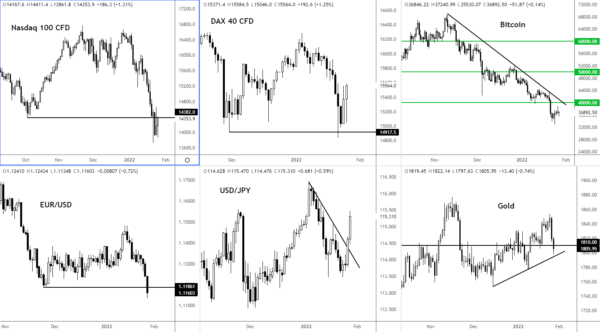The main takeaway from Jerome Powell’s press conference last night was that the Fed was even more hawkish than expected, causing even more volatility in the markets and further underpinning the US dollar against foreign currencies and gold. Powell effectively admitted the Fed has been behind the curve and now must get its act together to get inflation to more acceptable levels. If that means upsetting financial markets, then so be it. The fact that US futures have been able to regain some of their losses from last night is impressive, but will it be a repeat of the day before?
US economic growth trounced expectations
Today’s main data releases piled further pressure on gold as the dollar and stock index futures extended their gains. It was a simple maths equation for traders: Stronger US economy in Q4 + more hawkish Fed than expected = stronger US dollar. Economic output in the fourth quarter was 6.9% in an annualised format, rising sharply from an upwardly 2.3% in Q3 and easily beating expectations of 5.3% growth. The spread of Omicron in start of Q1 means growth likely slowed down a bit, but there are no signs of inflation easing. Against this backdrop, at least four rate hikes in 2022 is likely.
What does that mean for US stocks?
Well, if we assume that stimulus and low rates were among the major reasons behind the protracted bull run, then that support is no longer there or at least not in the same way. Value stocks – those in the financial sector and industrials – must now do the heavy lifting. But if those big tech stocks struggle, then it is hard to imagine the S&P 500 remaining at current levels for too long. The correction could extend further, and we might be in for more volatile price action in Q2.
Investors are also keeping an eye on company earnings, with Apple set to post its results after the closing bell. Tesla saw its shares drop after the company issued cautious comments on supply-chain troubles. Intel fell on the back of disappointing profit forecast.
What about the dollar?
Clearly, the Fed is going to hike rates multiple times this year and investors have boosted their expectations, with the probability of five 25 basis rate hikes climbing to a very high 94%. Meanwhile, it is difficult to see any other major central bank being nearly as hawkish. This should keep the USD/JPY and USD/CHF underpinned, when stocks are not selling off. But during times of heightened stock market volatility, the US dollar could perform better against commodity dollars like the Aussie, kiwi and loonie. So, FX traders need to be wary of the ever-changing risk sentiment when it comes to choosing which currency to short against the dollar.
Looking ahead, we will get policy updates from the likes of the RBA, BoE and ECB next week. In addition, there will be plenty o key data releases to look forward to as well, starting with the release of the Fed’s favourite inflation measure this Friday: Core PCE Price Index. Next week, we will have the latest monthly employment reports from the US, Canada and NZ. So, lots to look forward to for FX traders.















